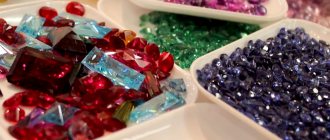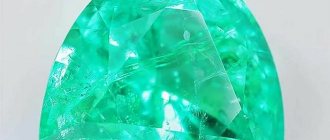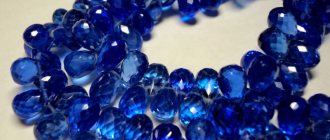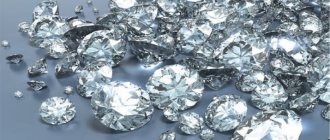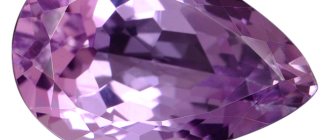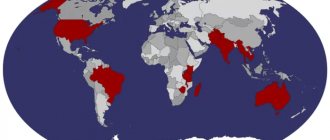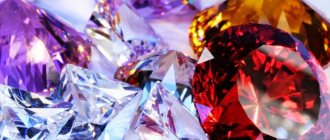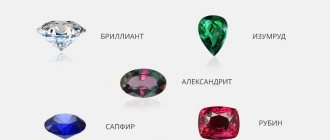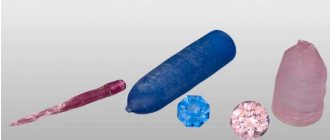History of the fishery
Legends about prospectors who mined treasures in the Ural Mountains go back centuries. In every village there is a tale about local residents who went to the mountains for gems and did not return.
The official history goes back three and a half centuries:
- The Tumashev brothers were the first to find colored pebbles in 1688, while exploring the Neiva River in the vicinity of Murzinskaya Sloboda. A colored stone boom began, and dozens of local peasants became miners.
- The first evidence of gem deposits along the banks of the Adui River dates back to the end of the 18th century.
The heyday of the fishery occurred during the reign of Catherine II (1762-1796).
The Empress patronized prospectors and kept the Yekaterinburg lapidary factory busy.
The 19th century was rich in discoveries:
- Magnificent beryls and amethysts are found. The discovery of the rarest red tourmalines was significant. They were caught by residents of the village of Shaitanka, the Kuznetsov brothers.
- Five years later, in 1815, the Mora mines were founded on the banks of the river. Connoisseurs all over the world still seek to buy local tourmalines today.
- By the end of the century, diamonds, sapphires, rubies, and malachite were discovered.
In 1900, local peasant Pyotr Rusin, while plowing a field, dug up miracle stones. So the village of Lipovskoye became a place of tourmaline mining. The guru of Soviet mineralogy, Academician Fersman, believed that in terms of beauty and depth of tone they were unrivaled.
Green tourmaline
The riches of the Urals are not exhausted; even tourists can, if they wish and have a bit of luck, find a pebble during an excursion.
Mineralogical and local history museums have been created in many cities of the Urals. The Rezhevsky State Natural and Mineralogical Reserve " Semi-precious Strip of the Urals " operates.
Academician Fersman argued that the Urals have no equal in the world in terms of the quantity and variety of minerals. But why exactly the Urals became the “box” of Russia, scientists are still figuring out.
Huge riches of the Urals
The region was “ignored” for a long time by the majority of scientists, and therefore industrialists. Although at the beginning of the 18th century, a local peasant brought almost half a kilogram of beryl to Yekaterinburg as an example. Even by the beginning of the 20th century, the mines were poorly described and were rarely visited by mineralogists.
However, the resources of the Urals have been used for more than two hundred years. For example, from just one mine on Adua (Murzinka) at the beginning of the 20th century, it was sometimes possible to produce more than 450 kg of cut aquamarine per year. The mines of the Southern Urals brought a lot of topaz.
Some stones have no equal in quality in the world, for example, cherry tourmaline. Back in the 18th century, the French called it siberite.
Precious
Almost all the minerals that jewelers and industrialists are interested in are found in the Urals.
Alexandrite
Some of the stones are especially prized, such as alexandrite, named after the Russian Tsar. The mineral was found in 1834. The largest deposit, Malyshevo, is located in the Urals.
The description of the stone is similar to an emerald, so at first they were confused. A little later, an optical effect was noticed, which was called alexandrite. The mineral turned out to be able to change color. Ural alexandrites have bright, rich shades of blue, green, red, and violet. These are expensive high quality stones.
Emerald
Emerald is another calling card of the Urals. The development of the deposits began in the 19th century, but the mines still hide a lot of wealth. So, five years ago, a kilogram emerald was discovered at the Malyshevsky deposit.
These Ural minerals have an intense green color due to the iron and chromium in their composition. Emerald is a fragile stone, so crystals without small defects are rarely found. If they are not there, this should alert you. This gemstone is often counterfeited. In natural emeralds, the cracks are filled with resin and treated with cedar oil using a special technology.
Topaz
Topaz is another pride of the Urals. The Ilmenskoe deposit is especially famous. During excavations near the Ugalinsky lakes, archaeologists were convinced that topazes were also valued by primitive people - products made from this stone were found.
They began mining the gem after the Cossack Prutov discovered the mineral in 1772. Most of the stones were found near the Sanarka and Kamenka rivers. Today, topaz deposits in the Urals are almost depleted.
Local minerals have different shades: from pink, yellow to intense wine, purple. In each mining area, topazes have their own shape and predominant color, for example:
- in Murzinka, Aduysky mines - yellow, blue;
- in the Southern Urals - pink, crimson.
Amethyst
According to experts, Ural amethysts are the best in the world. Stones found in other parts of the planet, as a rule, lose their saturation and play of color under artificial lighting. This cannot be said about natural Ural amethysts: they retain their shine. The gems that were found near Sanarka, Murzinki, are red.
Most Ural amethysts are purple. Abroad they are often called Siberian.
Demantoid
Demantoid is a green or yellowish stone related to garnets (andradite). Some minerals cost more than ten thousand dollars per carat. The best representatives are some of the most expensive gems.
The play of light on a crystal is no worse than on a diamond. Demantoids found in the Urals often have a ponytail. This is the name for byssolite impurities in the form of golden tufts. Such stones are valued higher.
A lot of demantoid is mined only in the Middle Urals. Samples from the Sysert region are popular and recognized. The world's largest deposit is Karkodinskoye.
Diamond
Diamond is known as one of the strongest stones. Often it is white, gray, black, less often - yellowish, brownish. Sometimes greenish, bluish, pinkish, colorless. Russia is in first place in terms of diamond reserves and production. Most stones are mined in Yakutia.
Until 1956, diamonds were mined only in the Urals: in the Perm (Molotov) region. The first crystal was found in 1829 near the Poludenka River. Today, the Perm Territory's share is only 0.1% of Russian production. Although the cost is already 2%. Ural diamonds are among the most expensive in the world. In addition, in Yakutia, getting them is from 3 to 12 times more expensive. For this reason, diamond mining in the Urals is unlikely to stop. Perhaps they will look for new deposits.
Mariinsky
Even today, discoveries are being made in the mountainous region. For example, in 2011, scientists from the Academy of Sciences discovered a new stone in the Urals. It is similar in composition to alexandrite. The name of the mineral is Mariinskite. It is green and does not change color in the light.
Ornamental
The following ornamental gems are distinguished.
Malachite
The collection “Malachite Box” by Bazhov has been translated into dozens of languages, and is recommended for schoolchildren by the Ministry of Education. The name was not chosen by chance. Malachite is truly one of the most recognizable ornamental stones of the Urals. This is a green mineral with a pattern. The shades and intensity of the shine differ.
Orlets
In the Urals there is a lot of orlets, or rhodonite of the highest quality. It has a cherry color. There are different shades that are combined with a pattern of veins and spots. Rhodonite was discovered in the Urals. The most famous deposit is located near the village of Maloe Sedelnikovo. Orlets is classified as a semi-precious ornamental mineral.
Jasper
Jasper is especially common in the Southern Urals. Here, entire rocks are made of it. The color of this variegated stone can be any, for example, Kalkan jasper is gray-green, Muldakaevskaya is gray-blue. In addition to the main tone, there are multi-colored spots and stripes in a unique combination. According to connoisseurs, local specimens are distinguished by their rare beauty. The minerals mined near the city of Orsk are distinguished.
Rose quartz
Rose quartz is also found in the Urals. Most crystals are cloudy and have cracks. The stone is used as an ornamental stone. Transparent rose quartz is sometimes found. This rare mineral is prized by jewelers.
What kind of gems is the Urals rich in?
In the Urals, gems of all orders are found, from precious to ornamental:
- Diamond, ruby, sapphire, emerald, alexandrite.
- Demantoid, rose quartz, aquamarine, amethyst, tourmaline, topaz, rauchtopaz, rock crystal.
- Malachite, rhodonite, jasper, serpentine.
Green malachite
Some gems are found for the first time or are mined only here, which affects the cost.
The minerals of the Urals are unique:
- Local emeralds are easily identified by their rich green color and clarity. Demantoids, called Ural emeralds, are similar to them.
Emeralds - The gem discovered by local scientists in 2011 is Mariinskite. According to the description, it is similar to alexandrite; the absence of pleochroism allows it to be distinguished. Named after the place of discovery - the Mariinsky mine. Its main characteristics: hardness, formula, composition are known. Esotericists study healing and magical properties.
- Shaitan's overflowing also looks like alexandrite. It was found by chance, on an emerald vein near the village of Shaitansky. It turned out that this is a layered variety of quartz of greenish-blue shades.
Shaitan overflow is mined only in the Urals, which increases its price on the world market for collectible stones.
Of particular importance is malachite, the main brand of the Urals. No wonder Pavel Petrovich Bazhov called the collection of his tales about the Urals “Malachite Box”.
Malachite box
Features of the Ural Mountains
Today, in the mines, mines and quarries of the Urals, up to 55 minerals that are important for production are extracted. The richness of the area is explained by the fact that the mountains were formed at the junction of two tectonic plates - Russian and West Siberian. As a result of this, slight fluctuations in the earth's crust still occur there. When studying the area, scientists came to one opinion: most of the minerals of the Urals, which are located on the surface and in the depths of the mountains, are the result of the eruption of an ancient volcano. Basalts, diabases, porphyrites, dolerites - all this burst out thousands of years ago, when magma was still raging here.
The stone fossils of the Urals are valuable not only for mining, but also for archaeological research into the history of the ancient world, which existed millions of years before the appearance of man. According to historical information, in the Paleozoic era there was the Perm Sea, which disappeared during a sharp cold snap. Thousands of prehistoric creatures left their imprints on stone blocks and in amber resin. Thanks to these finds, we can guess what animals lived in this area.
Rich deposits of metallic and non-metallic ores, precious stones and rare chemical minerals were found in the Ural mountains. Most of them were formed as a result of metamorphic and magmatic processes:
- Iron;
- Chrome;
- Copper;
- Nickel;
- Aluminum;
- Asbestos;
- Precious metals;
- Ornamental stones.
The mountains were also subject to sedimentary influence. The rocks eroded and eroded, exposing minerals, making them much easier to mine.
Place of Birth
The deposits are located throughout the mountain ranges - almost 100 km from north to south.
The most famous places for mining gems: Murzinka, Malyshevskoye, Shaitanka, Gumeshevsky.
Among the finds are a jewelry beryl crystal (25 cm; 1828, Murzinka) and a President emerald (crystal intergrowth of 1.2 kg; 1993, Malyshevsky mine).
Emerald President Malyshevsky mine
The term “Gem Strip of Russia” was coined at the beginning of the 20th century by the founder of the Department of Mineralogy of the Ural Mining Institute, Konstantin Matveev.
The USSR Post issued a series of stamps “Ural Gems” in 1963.
Buy landscape stone
No less popular is natural stone for landscape work. Indeed, today, more and more often, the area adjacent to the house is used not for a vegetable garden and garden bed, but for organizing various recreation areas with gazebos and barbecues, erecting supporting walls and alpine slides, as well as creating rockeries, decorative flower beds and ponds.
Granite, quartzite, marble, tuff, jasper, sea and river pebbles, as well as petrified wood and many other types of natural stone are widely used in the landscape.
Landscape stones of completely different shapes and sizes are used for design: they are in the form of huge boulders, blocks and cobblestones - to create compositions and walls; pebbles and stone chips of various rocks are used for sprinkling.
By contacting us, you can buy landscape stone of various types, all different shapes, fractions and colors. We work with individuals and corporate clients. We have a flexible system of discounts for wholesale buyers.
Where are gems used?
Use was found for all the gems. Some are used in jewelry, others are suitable for large items.
The property of the Hermitage is the Malachite Hall and a cameo carved on the overflow personally by Catherine II.
Malachite Hall
The columns of St. Isaac's Cathedral in St. Petersburg are lined with malachite.
Mantelpieces, tabletops, vases, and jewelry made from Ural stones are considered status items.
Gems from the Urals have different properties, characteristics, and values. But you need to take care of each product carefully.
Iron ores of the Urals
One of the most common valuable minerals in this area is magnetic iron ore. It is in the Urals that large accumulations of this rare material are concentrated. Magnetite is a mineral of black-metallic color; it is well attracted to a magnet, which is why it got its name. These raw materials are very important for the production of iron, steel and metal alloys. Russian deposits of magnetic iron ore are known throughout the world and are of enormous value.
But, most of all, brown iron ore, a fossil with a large amount of metal in its composition, is mined in the vicinity of the Urals. Most cast iron is made from this raw material. Red iron ore, hematite, and trace iron are also found. In industry they are of minor importance, being used to add to alloys to give them more ductile or hard properties.
Emeralds
Emeralds were first found in the Urals in 1830 in the roots of a wind-uprooted tree. Those samples were not distinguished by their purity and quality - they had a cloudy color and many cracks. However, the find indicated that there may be more attractive specimens nearby. Later, the master of the local lapidary factory, Yakov Kokovin, found rich veins of emerald near the Tokova River.
In 2013, a specimen weighing more than 1 kilogram was found in the Malyshevskoe deposit of the Urals, this indicates that the bowels of the Ural soil are still rich in precious stones; it is too early to talk about their depletion.
Ural emeralds have a rich green color due to the high content of chromium and iron impurities in the crystals. The mineral is very fragile, so samples without cracks and defects are very rare. Large, untreated crystals with no visible defects are most likely fake.
During processing, the cracks are filled with resin and treated with cedar oil, so the crystal takes on a more attractive appearance, while maintaining the magical properties of natural stone. It is cut using specially developed methods, as a result of which its beauty is revealed in full force.
Emerald is a fairly durable stone, but it must be stored separately from other jewelry so as not to scratch or damage its surface.
Emerald has strong energy and gives it to its owners. It is believed that he loves sincere people, for whom he will become a real talisman. Constantly wearing jewelry with emerald has a positive effect on a person’s character; he becomes kinder and gentler towards others.
Amethyst
A beautiful transparent mineral most often purple in color; Ural amethysts are distinguished by their purple color. In the layers of the earth, amethyst is found in the form of druses - crystals fused on a common quartz base, or geodes - voids of transparent materials filled with crystals. After calcination at a temperature of 470-750 degrees, amethyst crystals turn golden yellow; at higher temperatures they generally lose color. However, radiation exposure returns them to their original color.
Abroad, Ural amethysts are called Siberian; in the book “Gemstones” by Smir it is said that the British Museum of Natural History contains two Siberian amethysts. One of which weighs 90 carats, and the second – 75 carats. Both stones have a rich purple color.
According to scientists, Ural amethysts have no equal and look much more attractive than Ceylon and Brazilian stones. If amethysts from other countries lose their beauty from artificial lighting, then the Ural minerals retain the play of light and even glow with new red shades.
In the Urals, amethyst is called the stone of the Mother of God, the stone of family well-being and hearth. Esotericists advise removing jewelry with amethyst at night and placing it on a table in the center of the house so that its radiation spreads throughout the home.
Amethyst helps a person to improve, has a beneficial effect on his character, and at the same time warns the owner of the danger by changing color.
